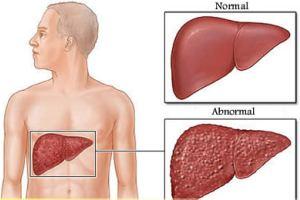Fatty liver diet does not sound appealing but it can help prevent illness. In some cases, it can be life saving.
What Is Fatty Liver?
According to the American Liver Foundation, fatty liver occurs when 10 percent or more of the organ's weight is fat. While fat in the organ is normal, excess adipose tissue can lead to complications. In some cases, the liver may become inflamed.
Inflammation leads to steatohepatitis, when alcohol is a factor. When alcohol is not a factor, the condition is called NASH (nonalcoholic steatohepatitis). Over time, the liver may become scarred and it may harden. When this occurs, the condition has progressed into cirrhosis, a very serious health problem that can lead to liver failure.
Causes
The liver is responsible for breaking down fats and when the organ is flooded with excess fat and calories on a regular basis, it is unable to break down the fats as it normally would. This leads to a build up of excess fat in the organ. People may be at risk for developing the condition if the following apply:
Diabetic
High triglycerides
Obese
Losing weight too quickly
Poor nutrition
Alcohol abuse
It is important to note that the condition may develop in people who are not at risk. Since the disease is asymptomatic, it is necessary to discuss testing options with your physician. The problem may be detected with a blood test or through a routine physical exam. The liver may be enlarged. A biopsy may be necessary for proper diagnosis.
Fatty Liver Diet
A diet for fatty liver can be a treatment, but some people may want to adopt this type of eating plan if they are at risk for developing the disease. One of the most important steps you can take is to adopt a healthy eating plan. Those who have nonalcoholic fatty liver disease want to stay away from high-glycemic carbohydrates.
High-glycemic carbohydrates
White bread
Breakfast cereal
White rice
Potatoes
The list is not comprehensive but it gives you a good idea of the types of food that can cause problems.
Developing and Eating Plan
Any diet for health conditions should be a collaborative process between you and your doctor. Your physician may refer you to a nutritionist to help you develop a healthy eating plan. A liver cleansing diet may be in order, involving detoxification but this can lead to unpleasant side effects and should be done with the guidance of a doctor.
What does a typical diet for fatty liver look like? Programs vary according to the individual's specific needs, making it critical to see a doctor about the best meal plans. A diet that helps you to lose abdominal weight may be helpful. General guidelines include:
Replace sugary treats with fruit
Avoid processed foods
Eat whole grains
Choose lean meats over red meat
Eat many vegetables
Make your own salad dressing using olive oil and vinegar, and use it sparingly
Add legumes to your recipes for added protein and fiber
As a rule of thumb, the closer the food is to its natural state, the better. The more processing the food goes through, the more additives are likely to be in the mix. The additives, extra calories and artificial ingredients have to be processed by the liver.
Alcohol
People who adopt a this diet should avoid alcoholic beverages, including people who have the nonalcoholic version of the disease. People who consume alcohol on a regular basis may be more likely to develop liver problems. Some suggest that a single glass of wine per day may be beneficial, but it is necessary to discuss this option with your physician.
Following healthy eating guidelines, avoiding processed foods and avoiding alcohol can help. However, the first step in determining whether a fatty liver diet is right for you is to consult your doctor.
Also, it is recommended to see:


No comments:
Post a Comment